Community Health Nursing: The Gullah-Geechee Community
VerifiedAdded on 2023/01/23
|18
|4857
|82
AI Summary
This community assessment paper discusses the Gullah-Geechee community of the US using secondary data, interviews, and a windshield survey. It explores the history, effects of developments, interventions, and health issues in the community.
Contribute Materials
Your contribution can guide someone’s learning journey. Share your
documents today.
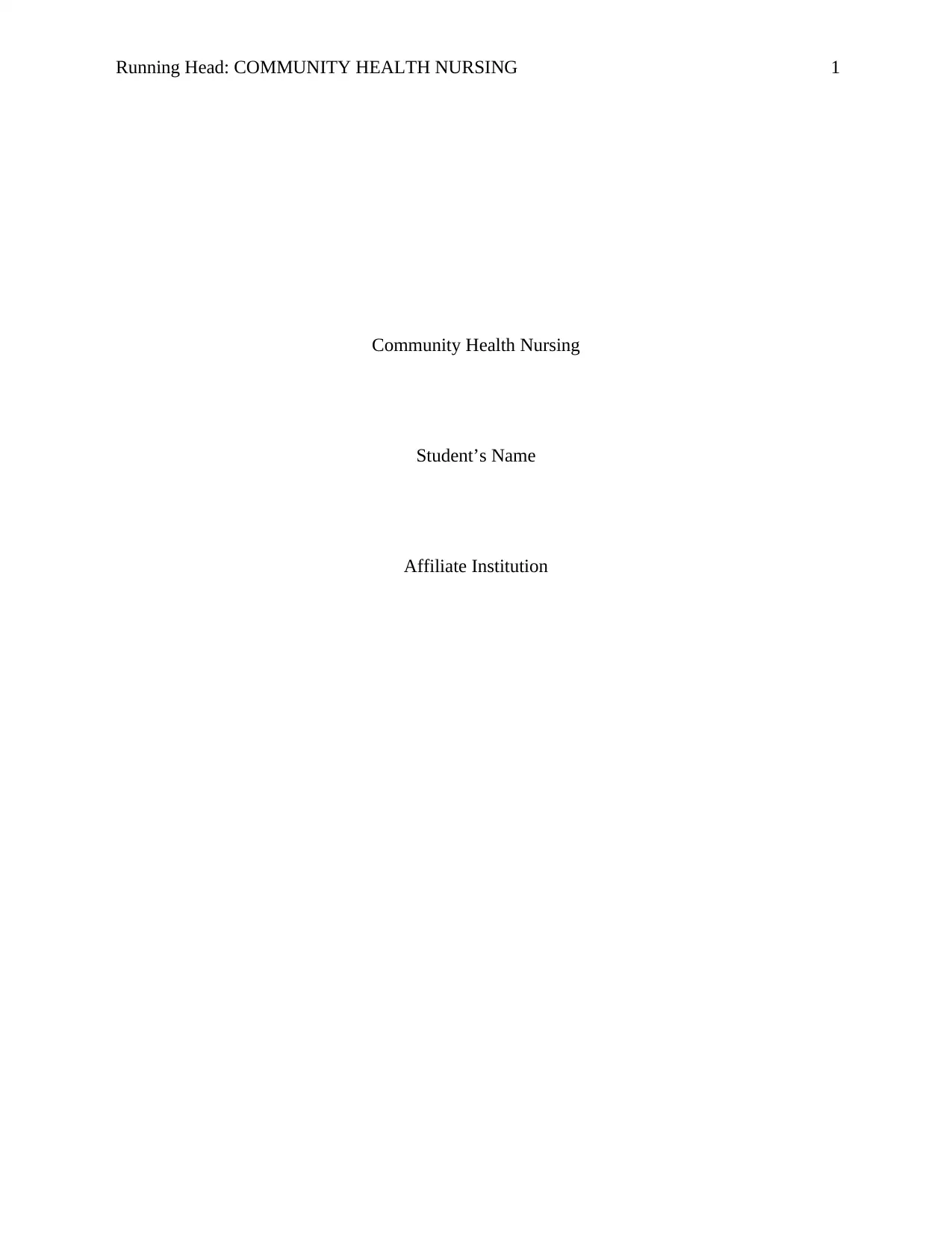
Running Head: COMMUNITY HEALTH NURSING 1
Community Health Nursing
Student’s Name
Affiliate Institution
Community Health Nursing
Student’s Name
Affiliate Institution
Secure Best Marks with AI Grader
Need help grading? Try our AI Grader for instant feedback on your assignments.
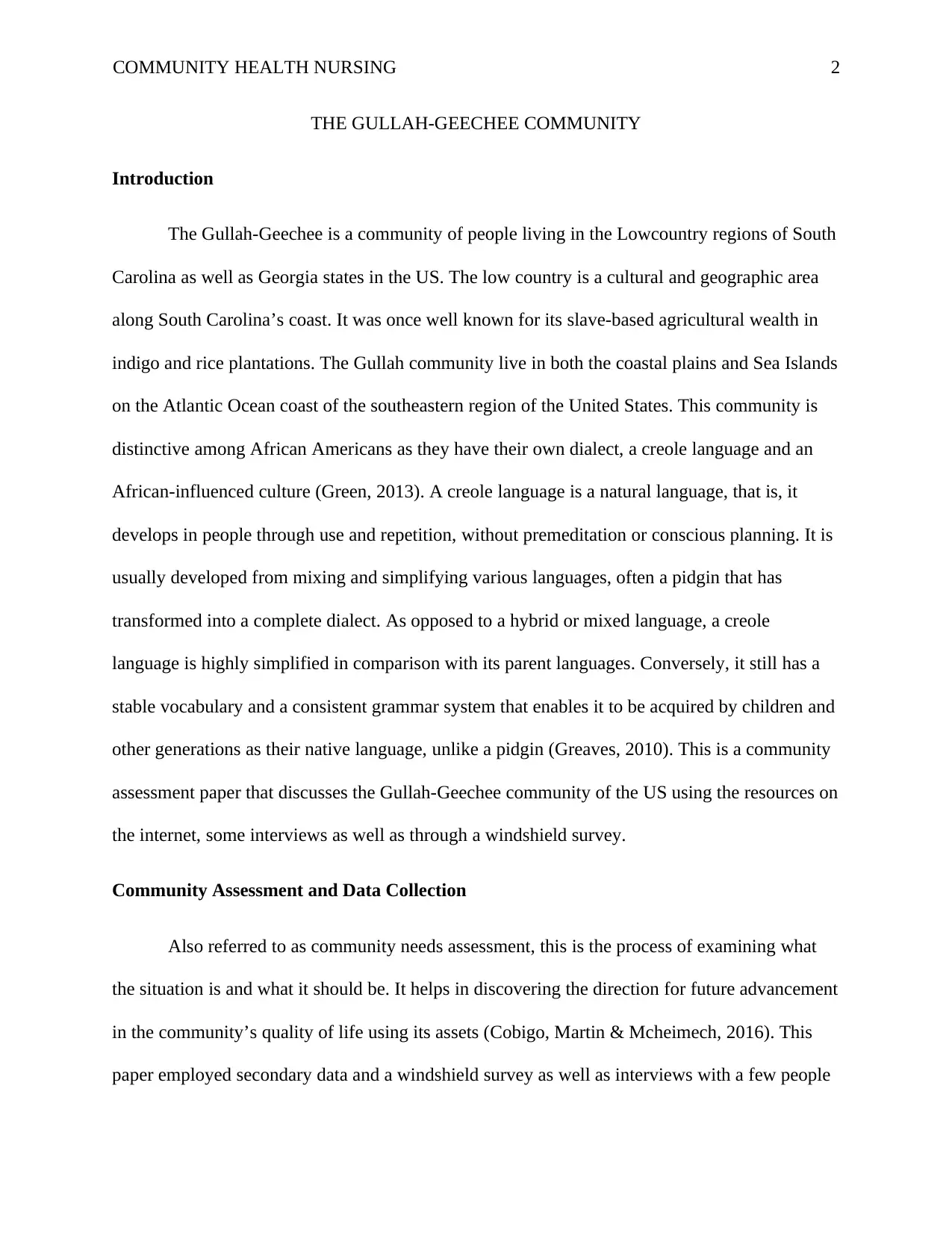
COMMUNITY HEALTH NURSING 2
THE GULLAH-GEECHEE COMMUNITY
Introduction
The Gullah-Geechee is a community of people living in the Lowcountry regions of South
Carolina as well as Georgia states in the US. The low country is a cultural and geographic area
along South Carolina’s coast. It was once well known for its slave-based agricultural wealth in
indigo and rice plantations. The Gullah community live in both the coastal plains and Sea Islands
on the Atlantic Ocean coast of the southeastern region of the United States. This community is
distinctive among African Americans as they have their own dialect, a creole language and an
African-influenced culture (Green, 2013). A creole language is a natural language, that is, it
develops in people through use and repetition, without premeditation or conscious planning. It is
usually developed from mixing and simplifying various languages, often a pidgin that has
transformed into a complete dialect. As opposed to a hybrid or mixed language, a creole
language is highly simplified in comparison with its parent languages. Conversely, it still has a
stable vocabulary and a consistent grammar system that enables it to be acquired by children and
other generations as their native language, unlike a pidgin (Greaves, 2010). This is a community
assessment paper that discusses the Gullah-Geechee community of the US using the resources on
the internet, some interviews as well as through a windshield survey.
Community Assessment and Data Collection
Also referred to as community needs assessment, this is the process of examining what
the situation is and what it should be. It helps in discovering the direction for future advancement
in the community’s quality of life using its assets (Cobigo, Martin & Mcheimech, 2016). This
paper employed secondary data and a windshield survey as well as interviews with a few people
THE GULLAH-GEECHEE COMMUNITY
Introduction
The Gullah-Geechee is a community of people living in the Lowcountry regions of South
Carolina as well as Georgia states in the US. The low country is a cultural and geographic area
along South Carolina’s coast. It was once well known for its slave-based agricultural wealth in
indigo and rice plantations. The Gullah community live in both the coastal plains and Sea Islands
on the Atlantic Ocean coast of the southeastern region of the United States. This community is
distinctive among African Americans as they have their own dialect, a creole language and an
African-influenced culture (Green, 2013). A creole language is a natural language, that is, it
develops in people through use and repetition, without premeditation or conscious planning. It is
usually developed from mixing and simplifying various languages, often a pidgin that has
transformed into a complete dialect. As opposed to a hybrid or mixed language, a creole
language is highly simplified in comparison with its parent languages. Conversely, it still has a
stable vocabulary and a consistent grammar system that enables it to be acquired by children and
other generations as their native language, unlike a pidgin (Greaves, 2010). This is a community
assessment paper that discusses the Gullah-Geechee community of the US using the resources on
the internet, some interviews as well as through a windshield survey.
Community Assessment and Data Collection
Also referred to as community needs assessment, this is the process of examining what
the situation is and what it should be. It helps in discovering the direction for future advancement
in the community’s quality of life using its assets (Cobigo, Martin & Mcheimech, 2016). This
paper employed secondary data and a windshield survey as well as interviews with a few people
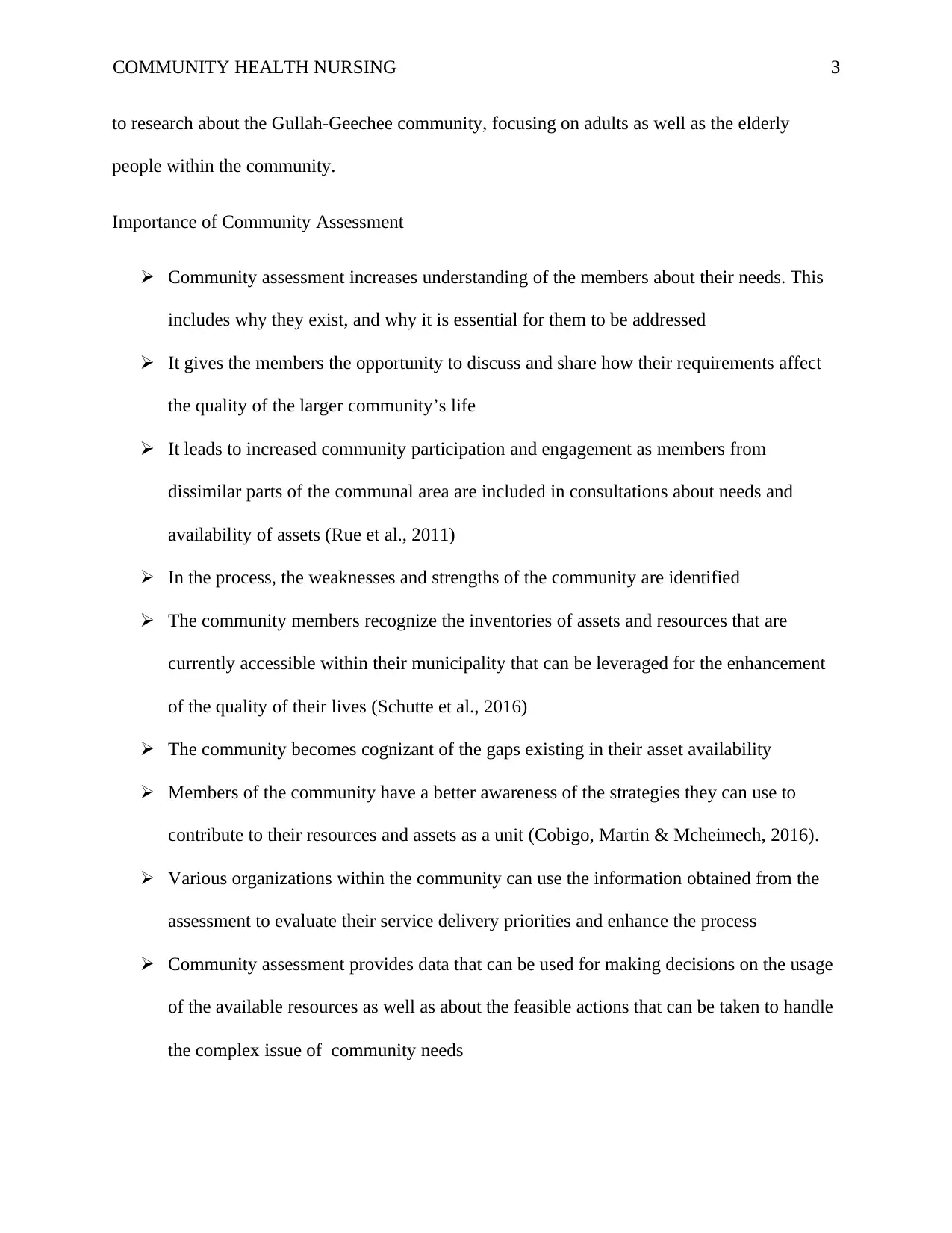
COMMUNITY HEALTH NURSING 3
to research about the Gullah-Geechee community, focusing on adults as well as the elderly
people within the community.
Importance of Community Assessment
Community assessment increases understanding of the members about their needs. This
includes why they exist, and why it is essential for them to be addressed
It gives the members the opportunity to discuss and share how their requirements affect
the quality of the larger community’s life
It leads to increased community participation and engagement as members from
dissimilar parts of the communal area are included in consultations about needs and
availability of assets (Rue et al., 2011)
In the process, the weaknesses and strengths of the community are identified
The community members recognize the inventories of assets and resources that are
currently accessible within their municipality that can be leveraged for the enhancement
of the quality of their lives (Schutte et al., 2016)
The community becomes cognizant of the gaps existing in their asset availability
Members of the community have a better awareness of the strategies they can use to
contribute to their resources and assets as a unit (Cobigo, Martin & Mcheimech, 2016).
Various organizations within the community can use the information obtained from the
assessment to evaluate their service delivery priorities and enhance the process
Community assessment provides data that can be used for making decisions on the usage
of the available resources as well as about the feasible actions that can be taken to handle
the complex issue of community needs
to research about the Gullah-Geechee community, focusing on adults as well as the elderly
people within the community.
Importance of Community Assessment
Community assessment increases understanding of the members about their needs. This
includes why they exist, and why it is essential for them to be addressed
It gives the members the opportunity to discuss and share how their requirements affect
the quality of the larger community’s life
It leads to increased community participation and engagement as members from
dissimilar parts of the communal area are included in consultations about needs and
availability of assets (Rue et al., 2011)
In the process, the weaknesses and strengths of the community are identified
The community members recognize the inventories of assets and resources that are
currently accessible within their municipality that can be leveraged for the enhancement
of the quality of their lives (Schutte et al., 2016)
The community becomes cognizant of the gaps existing in their asset availability
Members of the community have a better awareness of the strategies they can use to
contribute to their resources and assets as a unit (Cobigo, Martin & Mcheimech, 2016).
Various organizations within the community can use the information obtained from the
assessment to evaluate their service delivery priorities and enhance the process
Community assessment provides data that can be used for making decisions on the usage
of the available resources as well as about the feasible actions that can be taken to handle
the complex issue of community needs

COMMUNITY HEALTH NURSING 4
The data obtained can aid in setting priorities, strategic planning, program advances, and
their outcomes as well.
History of the Gullah-Geechee People
Enslaved Africans were shipped to America from Mozambique, Angola, Madagascar,
Gold Coast, and Sierra Leone. People had cultivated African rice for a long while in Africa prior
to the arrival of the colonialists (Singleton, 2012). After the British colonial planters in the South
of the country realized that African rice would do well in the region, they sought rice-growers
from Africa due to their knowledge and skills which were applicable in building dams, and
development of irrigation schemes and other earthworks. The slave trade was operated by two
companies from England at the slave castle in Bunce Island in Sierra Leone River where the
slaves were processed before being shipped to Georgia and South Carolina, two of the major
export sites. Slaves from diverse African beliefs, values, and ways of life were traded in South
Carolina hence the Creole culture of the Gullah-Geechee people (Fesler, 2010). These groups of
people include the Kissi, Baga, Mende, Mandinka, Susu, Fula, Limba, Temne, Kpelle, Wolof
and the Vai as well. By the mid-18th century, there were thousands of African rice fields tended
by the slaves, making rice farming one of the most fruitful industries in America at the time
(Barnes & Steen, 2012).
Windshield Survey and Interviews
The Gullah-Geechee community emerged from the enslaved Africans and thus have a
distinctive type of settlement that resembles the colonial slave quarters with the exception of the
rows in which the dwellings were grouped (Botwick, 2018). During the survey, it can be
observed that the family compound consists of loosely assembled abodes and outbuildings The
The data obtained can aid in setting priorities, strategic planning, program advances, and
their outcomes as well.
History of the Gullah-Geechee People
Enslaved Africans were shipped to America from Mozambique, Angola, Madagascar,
Gold Coast, and Sierra Leone. People had cultivated African rice for a long while in Africa prior
to the arrival of the colonialists (Singleton, 2012). After the British colonial planters in the South
of the country realized that African rice would do well in the region, they sought rice-growers
from Africa due to their knowledge and skills which were applicable in building dams, and
development of irrigation schemes and other earthworks. The slave trade was operated by two
companies from England at the slave castle in Bunce Island in Sierra Leone River where the
slaves were processed before being shipped to Georgia and South Carolina, two of the major
export sites. Slaves from diverse African beliefs, values, and ways of life were traded in South
Carolina hence the Creole culture of the Gullah-Geechee people (Fesler, 2010). These groups of
people include the Kissi, Baga, Mende, Mandinka, Susu, Fula, Limba, Temne, Kpelle, Wolof
and the Vai as well. By the mid-18th century, there were thousands of African rice fields tended
by the slaves, making rice farming one of the most fruitful industries in America at the time
(Barnes & Steen, 2012).
Windshield Survey and Interviews
The Gullah-Geechee community emerged from the enslaved Africans and thus have a
distinctive type of settlement that resembles the colonial slave quarters with the exception of the
rows in which the dwellings were grouped (Botwick, 2018). During the survey, it can be
observed that the family compound consists of loosely assembled abodes and outbuildings The
Secure Best Marks with AI Grader
Need help grading? Try our AI Grader for instant feedback on your assignments.
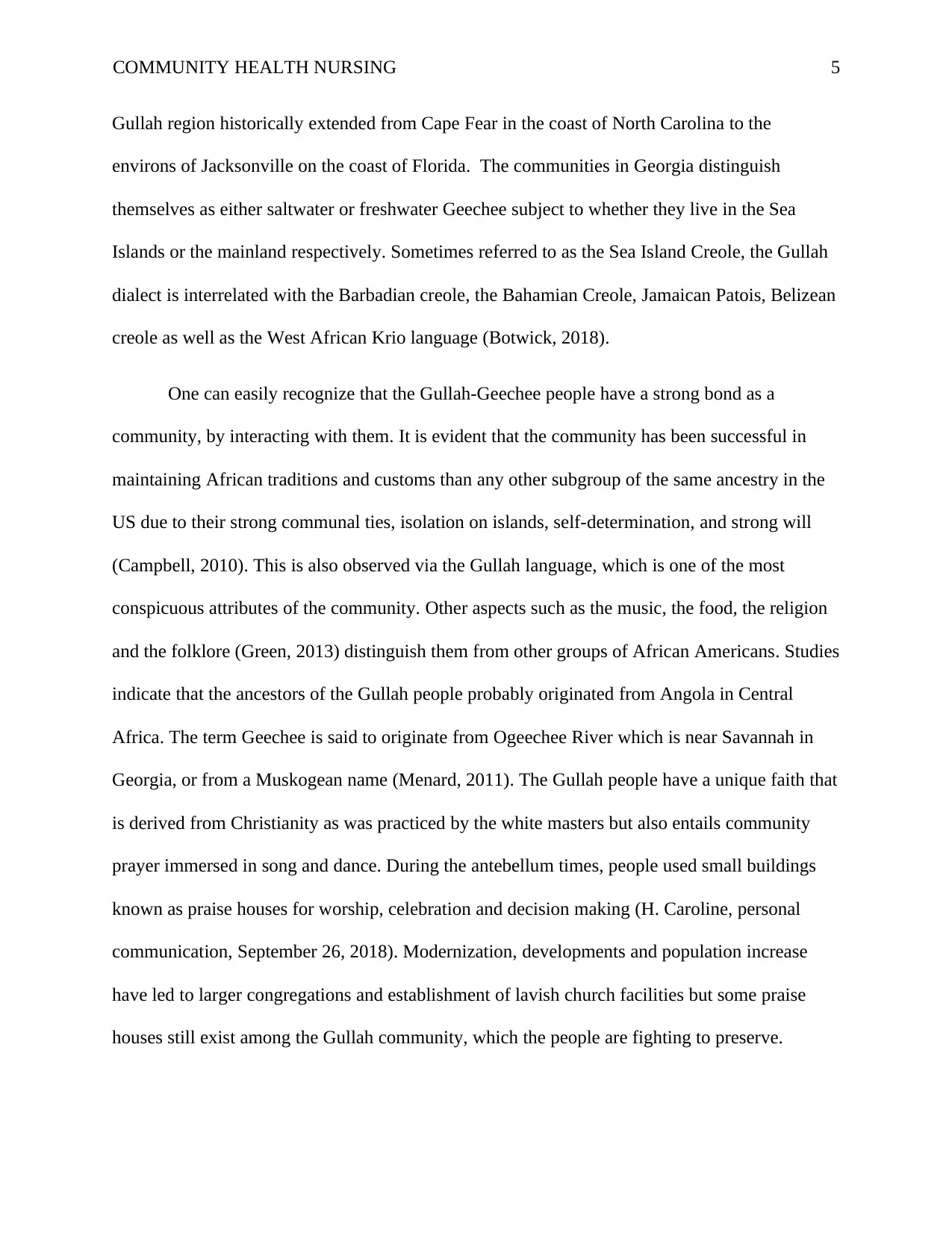
COMMUNITY HEALTH NURSING 5
Gullah region historically extended from Cape Fear in the coast of North Carolina to the
environs of Jacksonville on the coast of Florida. The communities in Georgia distinguish
themselves as either saltwater or freshwater Geechee subject to whether they live in the Sea
Islands or the mainland respectively. Sometimes referred to as the Sea Island Creole, the Gullah
dialect is interrelated with the Barbadian creole, the Bahamian Creole, Jamaican Patois, Belizean
creole as well as the West African Krio language (Botwick, 2018).
One can easily recognize that the Gullah-Geechee people have a strong bond as a
community, by interacting with them. It is evident that the community has been successful in
maintaining African traditions and customs than any other subgroup of the same ancestry in the
US due to their strong communal ties, isolation on islands, self-determination, and strong will
(Campbell, 2010). This is also observed via the Gullah language, which is one of the most
conspicuous attributes of the community. Other aspects such as the music, the food, the religion
and the folklore (Green, 2013) distinguish them from other groups of African Americans. Studies
indicate that the ancestors of the Gullah people probably originated from Angola in Central
Africa. The term Geechee is said to originate from Ogeechee River which is near Savannah in
Georgia, or from a Muskogean name (Menard, 2011). The Gullah people have a unique faith that
is derived from Christianity as was practiced by the white masters but also entails community
prayer immersed in song and dance. During the antebellum times, people used small buildings
known as praise houses for worship, celebration and decision making (H. Caroline, personal
communication, September 26, 2018). Modernization, developments and population increase
have led to larger congregations and establishment of lavish church facilities but some praise
houses still exist among the Gullah community, which the people are fighting to preserve.
Gullah region historically extended from Cape Fear in the coast of North Carolina to the
environs of Jacksonville on the coast of Florida. The communities in Georgia distinguish
themselves as either saltwater or freshwater Geechee subject to whether they live in the Sea
Islands or the mainland respectively. Sometimes referred to as the Sea Island Creole, the Gullah
dialect is interrelated with the Barbadian creole, the Bahamian Creole, Jamaican Patois, Belizean
creole as well as the West African Krio language (Botwick, 2018).
One can easily recognize that the Gullah-Geechee people have a strong bond as a
community, by interacting with them. It is evident that the community has been successful in
maintaining African traditions and customs than any other subgroup of the same ancestry in the
US due to their strong communal ties, isolation on islands, self-determination, and strong will
(Campbell, 2010). This is also observed via the Gullah language, which is one of the most
conspicuous attributes of the community. Other aspects such as the music, the food, the religion
and the folklore (Green, 2013) distinguish them from other groups of African Americans. Studies
indicate that the ancestors of the Gullah people probably originated from Angola in Central
Africa. The term Geechee is said to originate from Ogeechee River which is near Savannah in
Georgia, or from a Muskogean name (Menard, 2011). The Gullah people have a unique faith that
is derived from Christianity as was practiced by the white masters but also entails community
prayer immersed in song and dance. During the antebellum times, people used small buildings
known as praise houses for worship, celebration and decision making (H. Caroline, personal
communication, September 26, 2018). Modernization, developments and population increase
have led to larger congregations and establishment of lavish church facilities but some praise
houses still exist among the Gullah community, which the people are fighting to preserve.
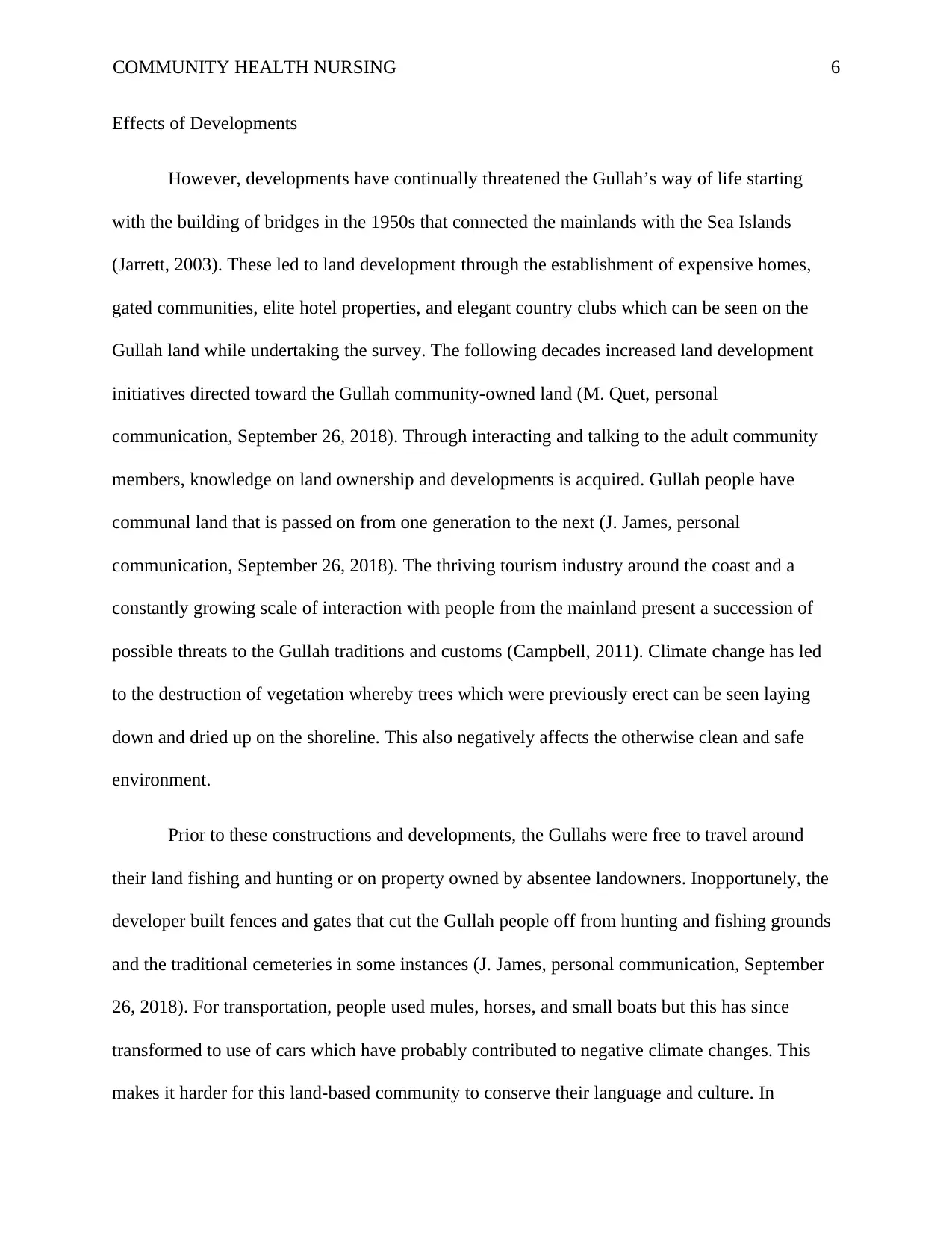
COMMUNITY HEALTH NURSING 6
Effects of Developments
However, developments have continually threatened the Gullah’s way of life starting
with the building of bridges in the 1950s that connected the mainlands with the Sea Islands
(Jarrett, 2003). These led to land development through the establishment of expensive homes,
gated communities, elite hotel properties, and elegant country clubs which can be seen on the
Gullah land while undertaking the survey. The following decades increased land development
initiatives directed toward the Gullah community-owned land (M. Quet, personal
communication, September 26, 2018). Through interacting and talking to the adult community
members, knowledge on land ownership and developments is acquired. Gullah people have
communal land that is passed on from one generation to the next (J. James, personal
communication, September 26, 2018). The thriving tourism industry around the coast and a
constantly growing scale of interaction with people from the mainland present a succession of
possible threats to the Gullah traditions and customs (Campbell, 2011). Climate change has led
to the destruction of vegetation whereby trees which were previously erect can be seen laying
down and dried up on the shoreline. This also negatively affects the otherwise clean and safe
environment.
Prior to these constructions and developments, the Gullahs were free to travel around
their land fishing and hunting or on property owned by absentee landowners. Inopportunely, the
developer built fences and gates that cut the Gullah people off from hunting and fishing grounds
and the traditional cemeteries in some instances (J. James, personal communication, September
26, 2018). For transportation, people used mules, horses, and small boats but this has since
transformed to use of cars which have probably contributed to negative climate changes. This
makes it harder for this land-based community to conserve their language and culture. In
Effects of Developments
However, developments have continually threatened the Gullah’s way of life starting
with the building of bridges in the 1950s that connected the mainlands with the Sea Islands
(Jarrett, 2003). These led to land development through the establishment of expensive homes,
gated communities, elite hotel properties, and elegant country clubs which can be seen on the
Gullah land while undertaking the survey. The following decades increased land development
initiatives directed toward the Gullah community-owned land (M. Quet, personal
communication, September 26, 2018). Through interacting and talking to the adult community
members, knowledge on land ownership and developments is acquired. Gullah people have
communal land that is passed on from one generation to the next (J. James, personal
communication, September 26, 2018). The thriving tourism industry around the coast and a
constantly growing scale of interaction with people from the mainland present a succession of
possible threats to the Gullah traditions and customs (Campbell, 2011). Climate change has led
to the destruction of vegetation whereby trees which were previously erect can be seen laying
down and dried up on the shoreline. This also negatively affects the otherwise clean and safe
environment.
Prior to these constructions and developments, the Gullahs were free to travel around
their land fishing and hunting or on property owned by absentee landowners. Inopportunely, the
developer built fences and gates that cut the Gullah people off from hunting and fishing grounds
and the traditional cemeteries in some instances (J. James, personal communication, September
26, 2018). For transportation, people used mules, horses, and small boats but this has since
transformed to use of cars which have probably contributed to negative climate changes. This
makes it harder for this land-based community to conserve their language and culture. In
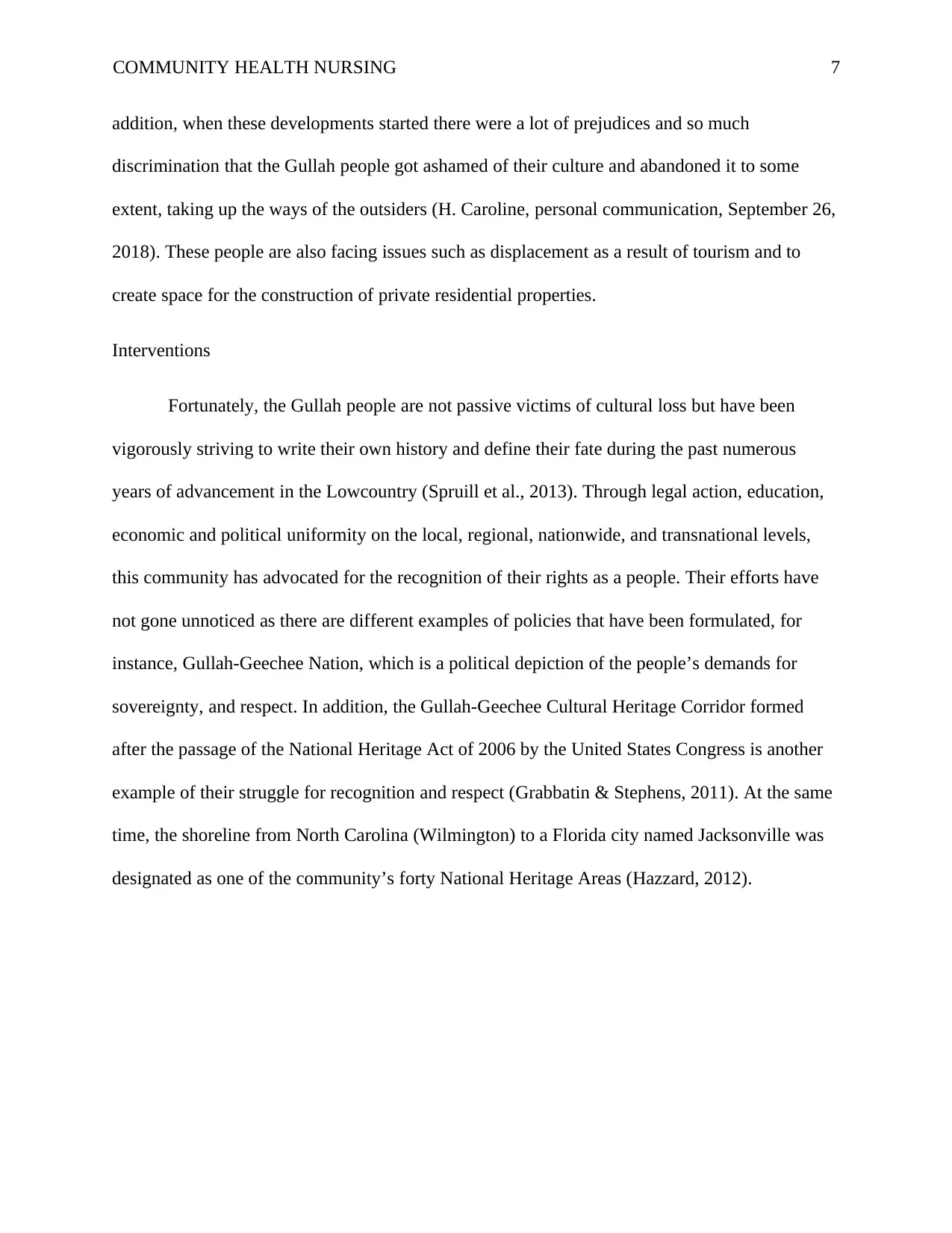
COMMUNITY HEALTH NURSING 7
addition, when these developments started there were a lot of prejudices and so much
discrimination that the Gullah people got ashamed of their culture and abandoned it to some
extent, taking up the ways of the outsiders (H. Caroline, personal communication, September 26,
2018). These people are also facing issues such as displacement as a result of tourism and to
create space for the construction of private residential properties.
Interventions
Fortunately, the Gullah people are not passive victims of cultural loss but have been
vigorously striving to write their own history and define their fate during the past numerous
years of advancement in the Lowcountry (Spruill et al., 2013). Through legal action, education,
economic and political uniformity on the local, regional, nationwide, and transnational levels,
this community has advocated for the recognition of their rights as a people. Their efforts have
not gone unnoticed as there are different examples of policies that have been formulated, for
instance, Gullah-Geechee Nation, which is a political depiction of the people’s demands for
sovereignty, and respect. In addition, the Gullah-Geechee Cultural Heritage Corridor formed
after the passage of the National Heritage Act of 2006 by the United States Congress is another
example of their struggle for recognition and respect (Grabbatin & Stephens, 2011). At the same
time, the shoreline from North Carolina (Wilmington) to a Florida city named Jacksonville was
designated as one of the community’s forty National Heritage Areas (Hazzard, 2012).
addition, when these developments started there were a lot of prejudices and so much
discrimination that the Gullah people got ashamed of their culture and abandoned it to some
extent, taking up the ways of the outsiders (H. Caroline, personal communication, September 26,
2018). These people are also facing issues such as displacement as a result of tourism and to
create space for the construction of private residential properties.
Interventions
Fortunately, the Gullah people are not passive victims of cultural loss but have been
vigorously striving to write their own history and define their fate during the past numerous
years of advancement in the Lowcountry (Spruill et al., 2013). Through legal action, education,
economic and political uniformity on the local, regional, nationwide, and transnational levels,
this community has advocated for the recognition of their rights as a people. Their efforts have
not gone unnoticed as there are different examples of policies that have been formulated, for
instance, Gullah-Geechee Nation, which is a political depiction of the people’s demands for
sovereignty, and respect. In addition, the Gullah-Geechee Cultural Heritage Corridor formed
after the passage of the National Heritage Act of 2006 by the United States Congress is another
example of their struggle for recognition and respect (Grabbatin & Stephens, 2011). At the same
time, the shoreline from North Carolina (Wilmington) to a Florida city named Jacksonville was
designated as one of the community’s forty National Heritage Areas (Hazzard, 2012).
Paraphrase This Document
Need a fresh take? Get an instant paraphrase of this document with our AI Paraphraser
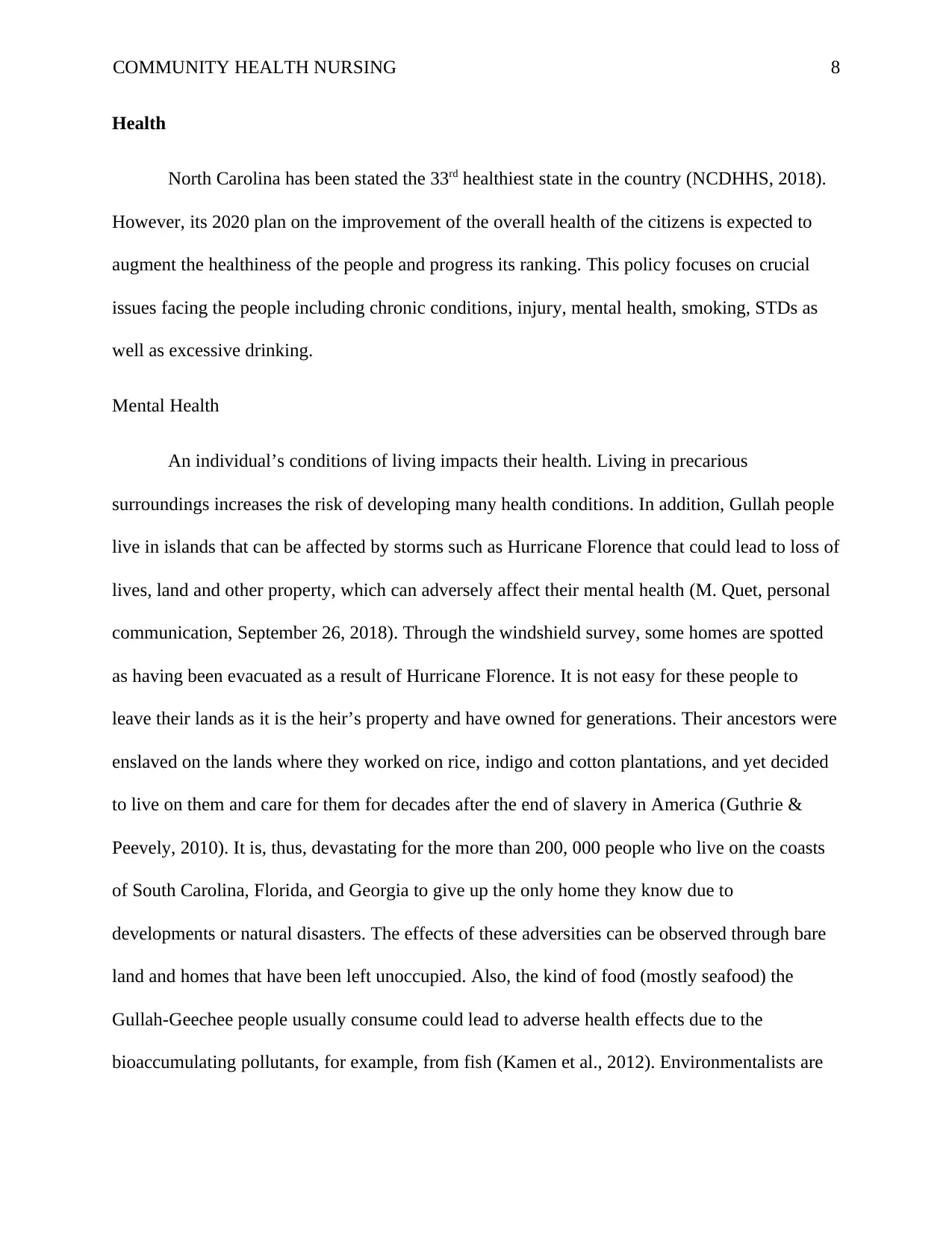
COMMUNITY HEALTH NURSING 8
Health
North Carolina has been stated the 33rd healthiest state in the country (NCDHHS, 2018).
However, its 2020 plan on the improvement of the overall health of the citizens is expected to
augment the healthiness of the people and progress its ranking. This policy focuses on crucial
issues facing the people including chronic conditions, injury, mental health, smoking, STDs as
well as excessive drinking.
Mental Health
An individual’s conditions of living impacts their health. Living in precarious
surroundings increases the risk of developing many health conditions. In addition, Gullah people
live in islands that can be affected by storms such as Hurricane Florence that could lead to loss of
lives, land and other property, which can adversely affect their mental health (M. Quet, personal
communication, September 26, 2018). Through the windshield survey, some homes are spotted
as having been evacuated as a result of Hurricane Florence. It is not easy for these people to
leave their lands as it is the heir’s property and have owned for generations. Their ancestors were
enslaved on the lands where they worked on rice, indigo and cotton plantations, and yet decided
to live on them and care for them for decades after the end of slavery in America (Guthrie &
Peevely, 2010). It is, thus, devastating for the more than 200, 000 people who live on the coasts
of South Carolina, Florida, and Georgia to give up the only home they know due to
developments or natural disasters. The effects of these adversities can be observed through bare
land and homes that have been left unoccupied. Also, the kind of food (mostly seafood) the
Gullah-Geechee people usually consume could lead to adverse health effects due to the
bioaccumulating pollutants, for example, from fish (Kamen et al., 2012). Environmentalists are
Health
North Carolina has been stated the 33rd healthiest state in the country (NCDHHS, 2018).
However, its 2020 plan on the improvement of the overall health of the citizens is expected to
augment the healthiness of the people and progress its ranking. This policy focuses on crucial
issues facing the people including chronic conditions, injury, mental health, smoking, STDs as
well as excessive drinking.
Mental Health
An individual’s conditions of living impacts their health. Living in precarious
surroundings increases the risk of developing many health conditions. In addition, Gullah people
live in islands that can be affected by storms such as Hurricane Florence that could lead to loss of
lives, land and other property, which can adversely affect their mental health (M. Quet, personal
communication, September 26, 2018). Through the windshield survey, some homes are spotted
as having been evacuated as a result of Hurricane Florence. It is not easy for these people to
leave their lands as it is the heir’s property and have owned for generations. Their ancestors were
enslaved on the lands where they worked on rice, indigo and cotton plantations, and yet decided
to live on them and care for them for decades after the end of slavery in America (Guthrie &
Peevely, 2010). It is, thus, devastating for the more than 200, 000 people who live on the coasts
of South Carolina, Florida, and Georgia to give up the only home they know due to
developments or natural disasters. The effects of these adversities can be observed through bare
land and homes that have been left unoccupied. Also, the kind of food (mostly seafood) the
Gullah-Geechee people usually consume could lead to adverse health effects due to the
bioaccumulating pollutants, for example, from fish (Kamen et al., 2012). Environmentalists are
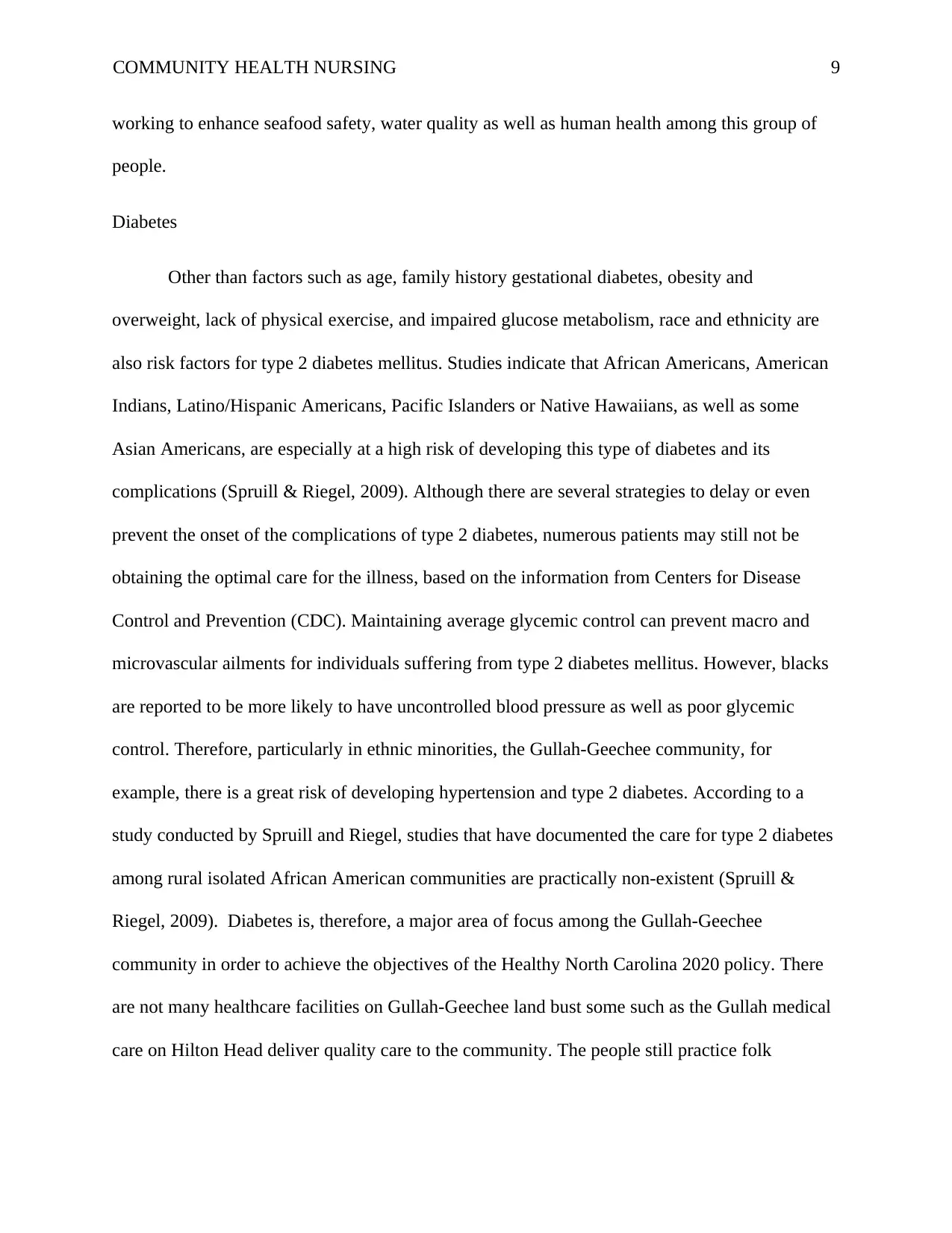
COMMUNITY HEALTH NURSING 9
working to enhance seafood safety, water quality as well as human health among this group of
people.
Diabetes
Other than factors such as age, family history gestational diabetes, obesity and
overweight, lack of physical exercise, and impaired glucose metabolism, race and ethnicity are
also risk factors for type 2 diabetes mellitus. Studies indicate that African Americans, American
Indians, Latino/Hispanic Americans, Pacific Islanders or Native Hawaiians, as well as some
Asian Americans, are especially at a high risk of developing this type of diabetes and its
complications (Spruill & Riegel, 2009). Although there are several strategies to delay or even
prevent the onset of the complications of type 2 diabetes, numerous patients may still not be
obtaining the optimal care for the illness, based on the information from Centers for Disease
Control and Prevention (CDC). Maintaining average glycemic control can prevent macro and
microvascular ailments for individuals suffering from type 2 diabetes mellitus. However, blacks
are reported to be more likely to have uncontrolled blood pressure as well as poor glycemic
control. Therefore, particularly in ethnic minorities, the Gullah-Geechee community, for
example, there is a great risk of developing hypertension and type 2 diabetes. According to a
study conducted by Spruill and Riegel, studies that have documented the care for type 2 diabetes
among rural isolated African American communities are practically non-existent (Spruill &
Riegel, 2009). Diabetes is, therefore, a major area of focus among the Gullah-Geechee
community in order to achieve the objectives of the Healthy North Carolina 2020 policy. There
are not many healthcare facilities on Gullah-Geechee land bust some such as the Gullah medical
care on Hilton Head deliver quality care to the community. The people still practice folk
working to enhance seafood safety, water quality as well as human health among this group of
people.
Diabetes
Other than factors such as age, family history gestational diabetes, obesity and
overweight, lack of physical exercise, and impaired glucose metabolism, race and ethnicity are
also risk factors for type 2 diabetes mellitus. Studies indicate that African Americans, American
Indians, Latino/Hispanic Americans, Pacific Islanders or Native Hawaiians, as well as some
Asian Americans, are especially at a high risk of developing this type of diabetes and its
complications (Spruill & Riegel, 2009). Although there are several strategies to delay or even
prevent the onset of the complications of type 2 diabetes, numerous patients may still not be
obtaining the optimal care for the illness, based on the information from Centers for Disease
Control and Prevention (CDC). Maintaining average glycemic control can prevent macro and
microvascular ailments for individuals suffering from type 2 diabetes mellitus. However, blacks
are reported to be more likely to have uncontrolled blood pressure as well as poor glycemic
control. Therefore, particularly in ethnic minorities, the Gullah-Geechee community, for
example, there is a great risk of developing hypertension and type 2 diabetes. According to a
study conducted by Spruill and Riegel, studies that have documented the care for type 2 diabetes
among rural isolated African American communities are practically non-existent (Spruill &
Riegel, 2009). Diabetes is, therefore, a major area of focus among the Gullah-Geechee
community in order to achieve the objectives of the Healthy North Carolina 2020 policy. There
are not many healthcare facilities on Gullah-Geechee land bust some such as the Gullah medical
care on Hilton Head deliver quality care to the community. The people still practice folk
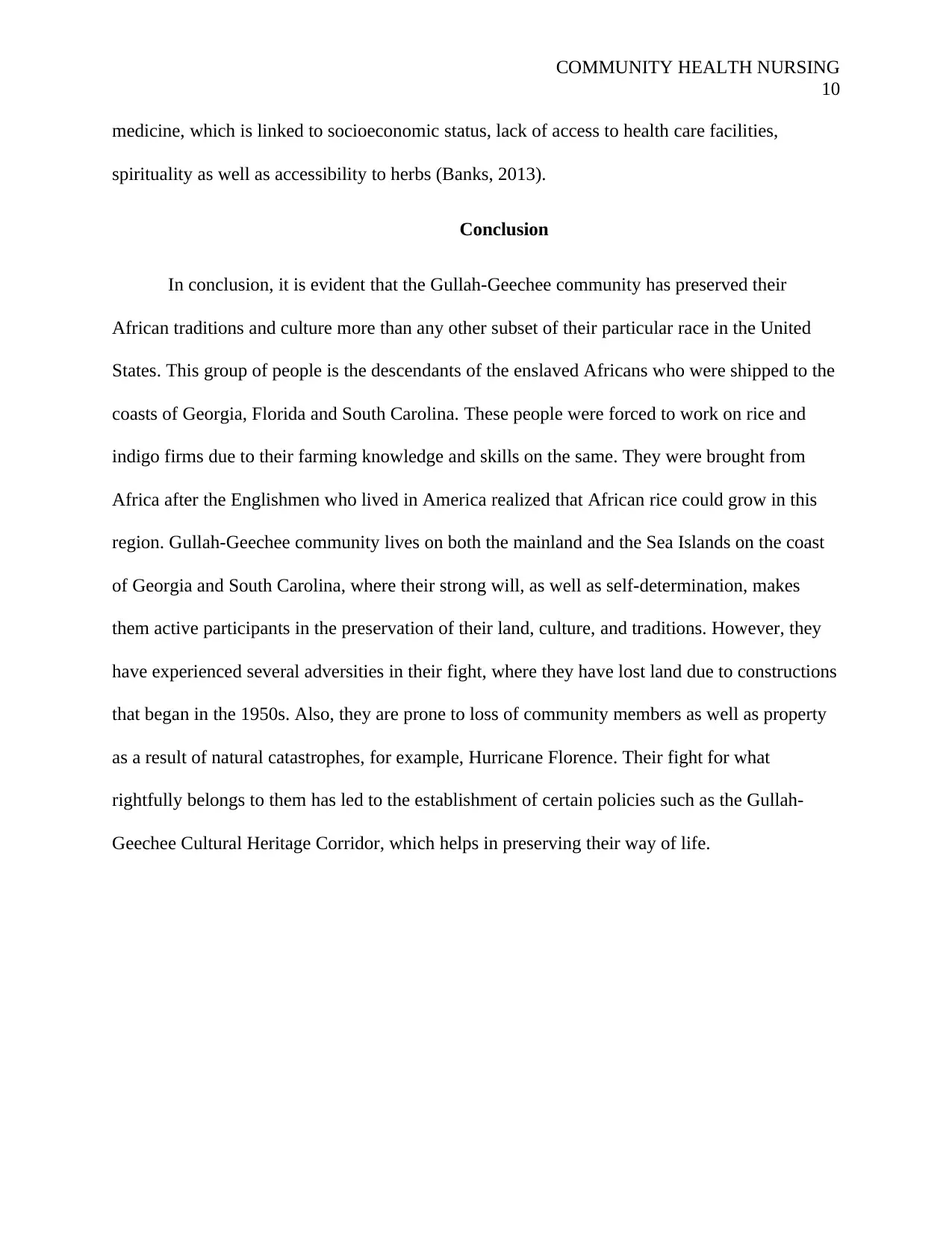
COMMUNITY HEALTH NURSING
10
medicine, which is linked to socioeconomic status, lack of access to health care facilities,
spirituality as well as accessibility to herbs (Banks, 2013).
Conclusion
In conclusion, it is evident that the Gullah-Geechee community has preserved their
African traditions and culture more than any other subset of their particular race in the United
States. This group of people is the descendants of the enslaved Africans who were shipped to the
coasts of Georgia, Florida and South Carolina. These people were forced to work on rice and
indigo firms due to their farming knowledge and skills on the same. They were brought from
Africa after the Englishmen who lived in America realized that African rice could grow in this
region. Gullah-Geechee community lives on both the mainland and the Sea Islands on the coast
of Georgia and South Carolina, where their strong will, as well as self-determination, makes
them active participants in the preservation of their land, culture, and traditions. However, they
have experienced several adversities in their fight, where they have lost land due to constructions
that began in the 1950s. Also, they are prone to loss of community members as well as property
as a result of natural catastrophes, for example, Hurricane Florence. Their fight for what
rightfully belongs to them has led to the establishment of certain policies such as the Gullah-
Geechee Cultural Heritage Corridor, which helps in preserving their way of life.
10
medicine, which is linked to socioeconomic status, lack of access to health care facilities,
spirituality as well as accessibility to herbs (Banks, 2013).
Conclusion
In conclusion, it is evident that the Gullah-Geechee community has preserved their
African traditions and culture more than any other subset of their particular race in the United
States. This group of people is the descendants of the enslaved Africans who were shipped to the
coasts of Georgia, Florida and South Carolina. These people were forced to work on rice and
indigo firms due to their farming knowledge and skills on the same. They were brought from
Africa after the Englishmen who lived in America realized that African rice could grow in this
region. Gullah-Geechee community lives on both the mainland and the Sea Islands on the coast
of Georgia and South Carolina, where their strong will, as well as self-determination, makes
them active participants in the preservation of their land, culture, and traditions. However, they
have experienced several adversities in their fight, where they have lost land due to constructions
that began in the 1950s. Also, they are prone to loss of community members as well as property
as a result of natural catastrophes, for example, Hurricane Florence. Their fight for what
rightfully belongs to them has led to the establishment of certain policies such as the Gullah-
Geechee Cultural Heritage Corridor, which helps in preserving their way of life.
Secure Best Marks with AI Grader
Need help grading? Try our AI Grader for instant feedback on your assignments.
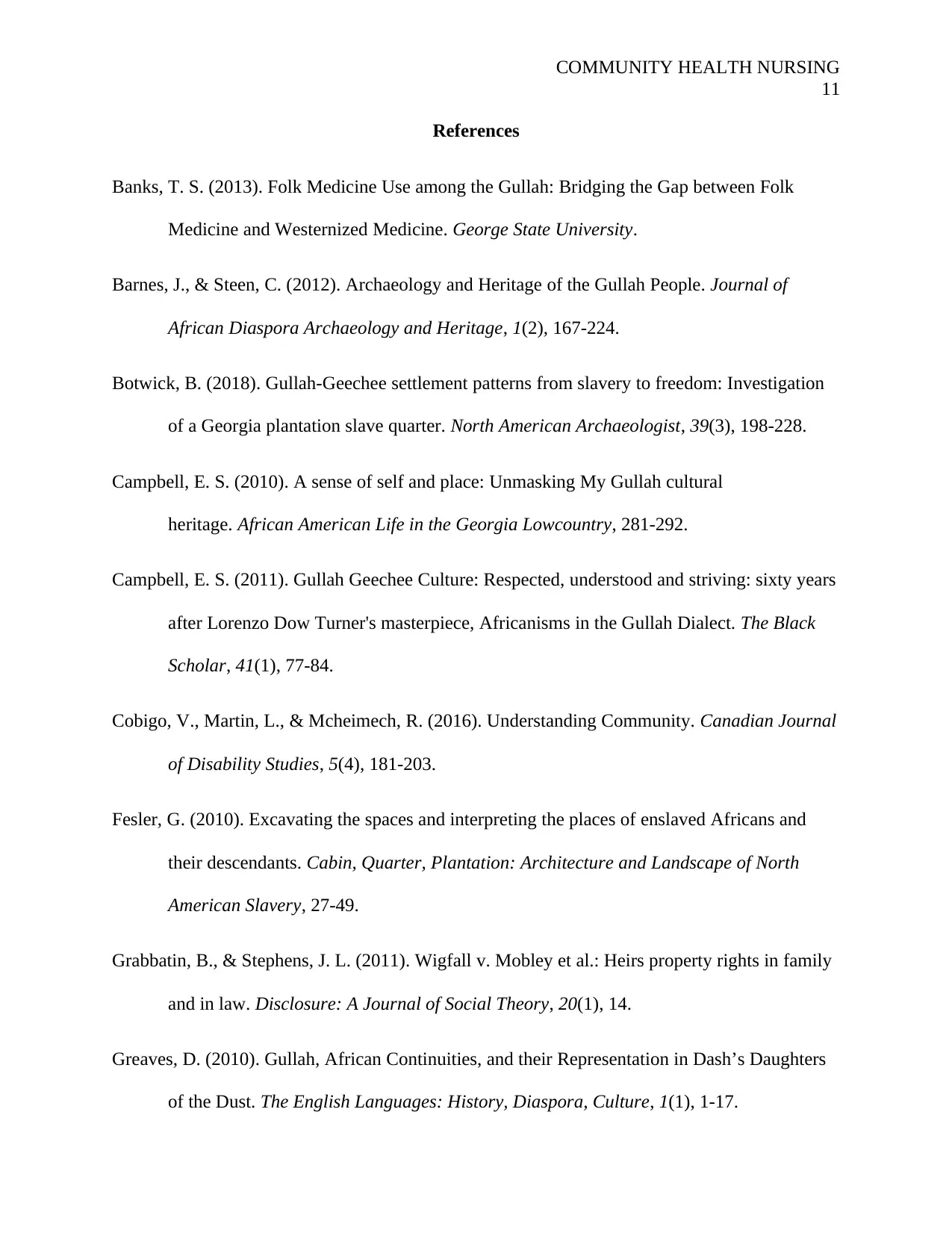
COMMUNITY HEALTH NURSING
11
References
Banks, T. S. (2013). Folk Medicine Use among the Gullah: Bridging the Gap between Folk
Medicine and Westernized Medicine. George State University.
Barnes, J., & Steen, C. (2012). Archaeology and Heritage of the Gullah People. Journal of
African Diaspora Archaeology and Heritage, 1(2), 167-224.
Botwick, B. (2018). Gullah-Geechee settlement patterns from slavery to freedom: Investigation
of a Georgia plantation slave quarter. North American Archaeologist, 39(3), 198-228.
Campbell, E. S. (2010). A sense of self and place: Unmasking My Gullah cultural
heritage. African American Life in the Georgia Lowcountry, 281-292.
Campbell, E. S. (2011). Gullah Geechee Culture: Respected, understood and striving: sixty years
after Lorenzo Dow Turner's masterpiece, Africanisms in the Gullah Dialect. The Black
Scholar, 41(1), 77-84.
Cobigo, V., Martin, L., & Mcheimech, R. (2016). Understanding Community. Canadian Journal
of Disability Studies, 5(4), 181-203.
Fesler, G. (2010). Excavating the spaces and interpreting the places of enslaved Africans and
their descendants. Cabin, Quarter, Plantation: Architecture and Landscape of North
American Slavery, 27-49.
Grabbatin, B., & Stephens, J. L. (2011). Wigfall v. Mobley et al.: Heirs property rights in family
and in law. Disclosure: A Journal of Social Theory, 20(1), 14.
Greaves, D. (2010). Gullah, African Continuities, and their Representation in Dash’s Daughters
of the Dust. The English Languages: History, Diaspora, Culture, 1(1), 1-17.
11
References
Banks, T. S. (2013). Folk Medicine Use among the Gullah: Bridging the Gap between Folk
Medicine and Westernized Medicine. George State University.
Barnes, J., & Steen, C. (2012). Archaeology and Heritage of the Gullah People. Journal of
African Diaspora Archaeology and Heritage, 1(2), 167-224.
Botwick, B. (2018). Gullah-Geechee settlement patterns from slavery to freedom: Investigation
of a Georgia plantation slave quarter. North American Archaeologist, 39(3), 198-228.
Campbell, E. S. (2010). A sense of self and place: Unmasking My Gullah cultural
heritage. African American Life in the Georgia Lowcountry, 281-292.
Campbell, E. S. (2011). Gullah Geechee Culture: Respected, understood and striving: sixty years
after Lorenzo Dow Turner's masterpiece, Africanisms in the Gullah Dialect. The Black
Scholar, 41(1), 77-84.
Cobigo, V., Martin, L., & Mcheimech, R. (2016). Understanding Community. Canadian Journal
of Disability Studies, 5(4), 181-203.
Fesler, G. (2010). Excavating the spaces and interpreting the places of enslaved Africans and
their descendants. Cabin, Quarter, Plantation: Architecture and Landscape of North
American Slavery, 27-49.
Grabbatin, B., & Stephens, J. L. (2011). Wigfall v. Mobley et al.: Heirs property rights in family
and in law. Disclosure: A Journal of Social Theory, 20(1), 14.
Greaves, D. (2010). Gullah, African Continuities, and their Representation in Dash’s Daughters
of the Dust. The English Languages: History, Diaspora, Culture, 1(1), 1-17.
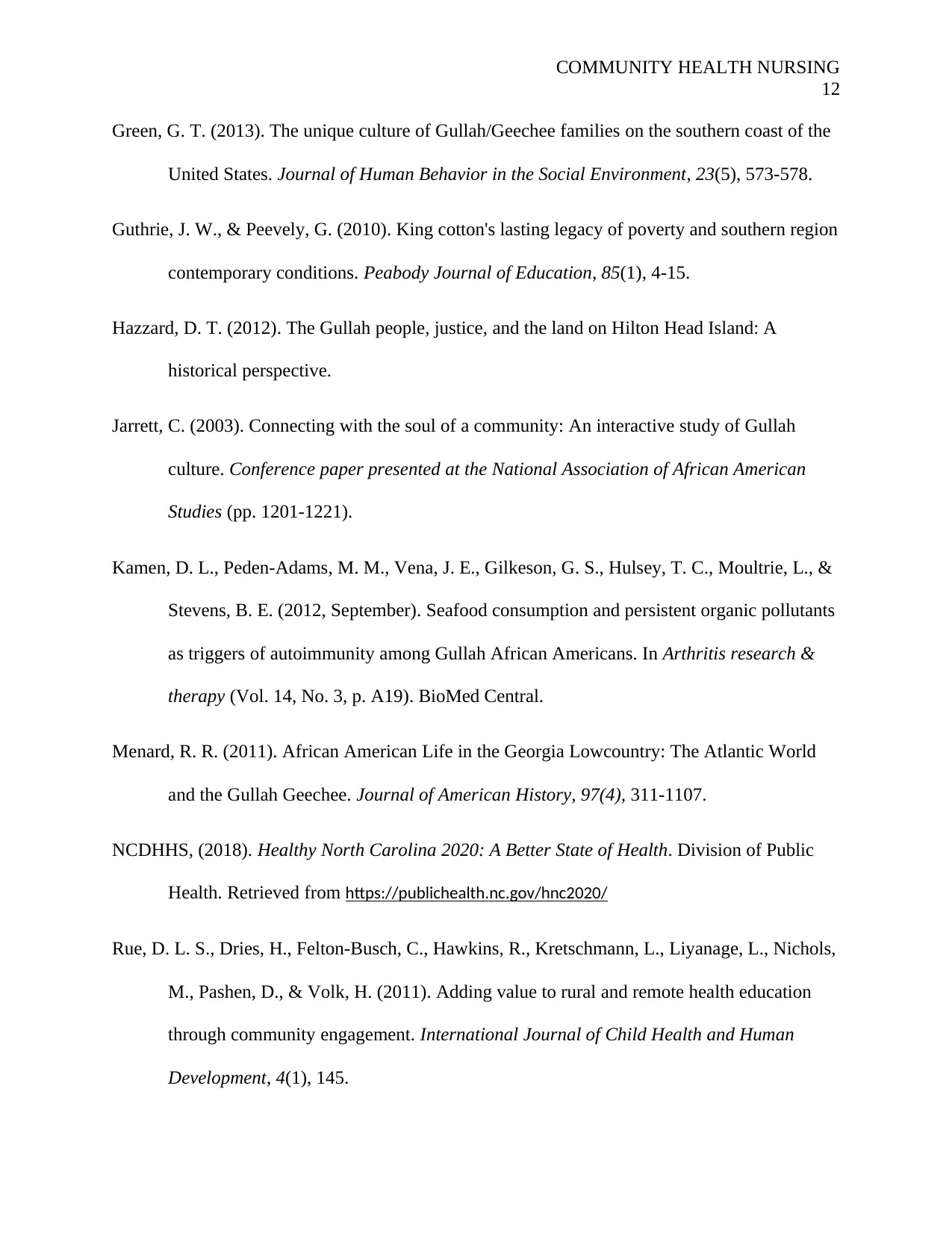
COMMUNITY HEALTH NURSING
12
Green, G. T. (2013). The unique culture of Gullah/Geechee families on the southern coast of the
United States. Journal of Human Behavior in the Social Environment, 23(5), 573-578.
Guthrie, J. W., & Peevely, G. (2010). King cotton's lasting legacy of poverty and southern region
contemporary conditions. Peabody Journal of Education, 85(1), 4-15.
Hazzard, D. T. (2012). The Gullah people, justice, and the land on Hilton Head Island: A
historical perspective.
Jarrett, C. (2003). Connecting with the soul of a community: An interactive study of Gullah
culture. Conference paper presented at the National Association of African American
Studies (pp. 1201-1221).
Kamen, D. L., Peden-Adams, M. M., Vena, J. E., Gilkeson, G. S., Hulsey, T. C., Moultrie, L., &
Stevens, B. E. (2012, September). Seafood consumption and persistent organic pollutants
as triggers of autoimmunity among Gullah African Americans. In Arthritis research &
therapy (Vol. 14, No. 3, p. A19). BioMed Central.
Menard, R. R. (2011). African American Life in the Georgia Lowcountry: The Atlantic World
and the Gullah Geechee. Journal of American History, 97(4), 311-1107.
NCDHHS, (2018). Healthy North Carolina 2020: A Better State of Health. Division of Public
Health. Retrieved from https://publichealth.nc.gov/hnc2020/
Rue, D. L. S., Dries, H., Felton-Busch, C., Hawkins, R., Kretschmann, L., Liyanage, L., Nichols,
M., Pashen, D., & Volk, H. (2011). Adding value to rural and remote health education
through community engagement. International Journal of Child Health and Human
Development, 4(1), 145.
12
Green, G. T. (2013). The unique culture of Gullah/Geechee families on the southern coast of the
United States. Journal of Human Behavior in the Social Environment, 23(5), 573-578.
Guthrie, J. W., & Peevely, G. (2010). King cotton's lasting legacy of poverty and southern region
contemporary conditions. Peabody Journal of Education, 85(1), 4-15.
Hazzard, D. T. (2012). The Gullah people, justice, and the land on Hilton Head Island: A
historical perspective.
Jarrett, C. (2003). Connecting with the soul of a community: An interactive study of Gullah
culture. Conference paper presented at the National Association of African American
Studies (pp. 1201-1221).
Kamen, D. L., Peden-Adams, M. M., Vena, J. E., Gilkeson, G. S., Hulsey, T. C., Moultrie, L., &
Stevens, B. E. (2012, September). Seafood consumption and persistent organic pollutants
as triggers of autoimmunity among Gullah African Americans. In Arthritis research &
therapy (Vol. 14, No. 3, p. A19). BioMed Central.
Menard, R. R. (2011). African American Life in the Georgia Lowcountry: The Atlantic World
and the Gullah Geechee. Journal of American History, 97(4), 311-1107.
NCDHHS, (2018). Healthy North Carolina 2020: A Better State of Health. Division of Public
Health. Retrieved from https://publichealth.nc.gov/hnc2020/
Rue, D. L. S., Dries, H., Felton-Busch, C., Hawkins, R., Kretschmann, L., Liyanage, L., Nichols,
M., Pashen, D., & Volk, H. (2011). Adding value to rural and remote health education
through community engagement. International Journal of Child Health and Human
Development, 4(1), 145.

COMMUNITY HEALTH NURSING
13
Schutte, D. L., Goris, E. D., Rivard, J. L., Schutte, B. C., & CoSAGE Community Research
Advisement Committee. (2016). Community Health Needs Assessment in a Rural
Setting: Foundation for a Community-Academic Partnership. Journal of Higher
Education Outreach and Engagement, 20(2), 85-108.
Singleton, T. A. (2012). Archaeology and Slavery. In The Oxford Handbook of Slavery in the
Americas. Oxford University Press.
Spruill, I. J., Leite, R. S., Fernandes, J. K., Kamen, D. L., Ford, M. E., Jenkins, C., ... &
Andrews, J. O. (2013). Successes, challenges, and lessons learned: Community-engaged
research with South Carolina’s Gullah population. Gateways: international journal of
community research & engagement, 6.
Spruill, I., & Riegel, B. (2009). The Quality of Diabetes Care to Gullah Families of South
Carolina. Journal of National Black Nurses' Association: JNBNA. 19. 20-7.
13
Schutte, D. L., Goris, E. D., Rivard, J. L., Schutte, B. C., & CoSAGE Community Research
Advisement Committee. (2016). Community Health Needs Assessment in a Rural
Setting: Foundation for a Community-Academic Partnership. Journal of Higher
Education Outreach and Engagement, 20(2), 85-108.
Singleton, T. A. (2012). Archaeology and Slavery. In The Oxford Handbook of Slavery in the
Americas. Oxford University Press.
Spruill, I. J., Leite, R. S., Fernandes, J. K., Kamen, D. L., Ford, M. E., Jenkins, C., ... &
Andrews, J. O. (2013). Successes, challenges, and lessons learned: Community-engaged
research with South Carolina’s Gullah population. Gateways: international journal of
community research & engagement, 6.
Spruill, I., & Riegel, B. (2009). The Quality of Diabetes Care to Gullah Families of South
Carolina. Journal of National Black Nurses' Association: JNBNA. 19. 20-7.
Paraphrase This Document
Need a fresh take? Get an instant paraphrase of this document with our AI Paraphraser
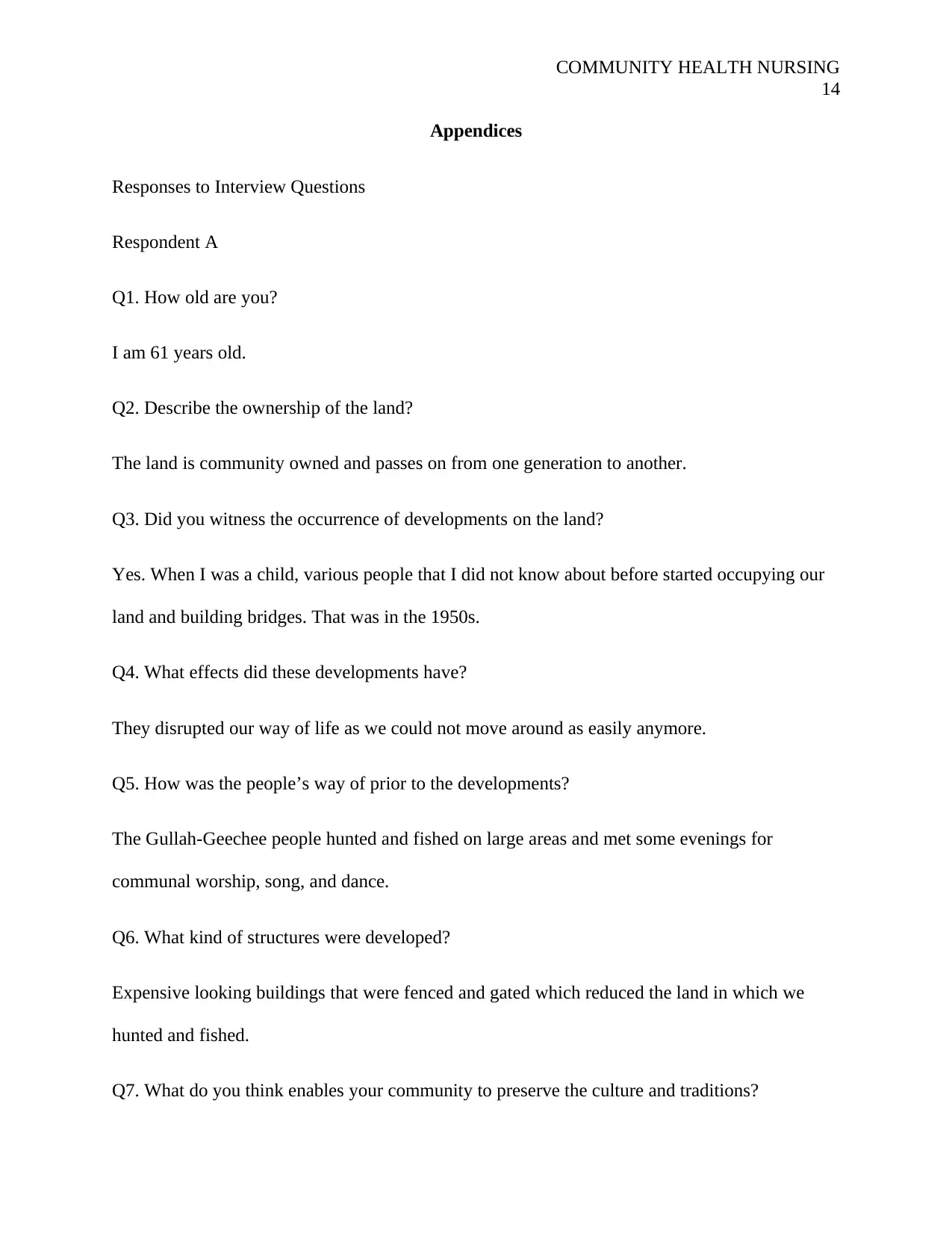
COMMUNITY HEALTH NURSING
14
Appendices
Responses to Interview Questions
Respondent A
Q1. How old are you?
I am 61 years old.
Q2. Describe the ownership of the land?
The land is community owned and passes on from one generation to another.
Q3. Did you witness the occurrence of developments on the land?
Yes. When I was a child, various people that I did not know about before started occupying our
land and building bridges. That was in the 1950s.
Q4. What effects did these developments have?
They disrupted our way of life as we could not move around as easily anymore.
Q5. How was the people’s way of prior to the developments?
The Gullah-Geechee people hunted and fished on large areas and met some evenings for
communal worship, song, and dance.
Q6. What kind of structures were developed?
Expensive looking buildings that were fenced and gated which reduced the land in which we
hunted and fished.
Q7. What do you think enables your community to preserve the culture and traditions?
14
Appendices
Responses to Interview Questions
Respondent A
Q1. How old are you?
I am 61 years old.
Q2. Describe the ownership of the land?
The land is community owned and passes on from one generation to another.
Q3. Did you witness the occurrence of developments on the land?
Yes. When I was a child, various people that I did not know about before started occupying our
land and building bridges. That was in the 1950s.
Q4. What effects did these developments have?
They disrupted our way of life as we could not move around as easily anymore.
Q5. How was the people’s way of prior to the developments?
The Gullah-Geechee people hunted and fished on large areas and met some evenings for
communal worship, song, and dance.
Q6. What kind of structures were developed?
Expensive looking buildings that were fenced and gated which reduced the land in which we
hunted and fished.
Q7. What do you think enables your community to preserve the culture and traditions?

COMMUNITY HEALTH NURSING
15
Our ancestors made this land their own and continued with their customs and traditions. They
instilled in us the will to be a united community and live our way of life without worrying about
the folks elsewhere.
Q8. How do you react to natural disasters?
Some people have moved from the lands but most have stayed on.
Q9. What health conditions do you suffer from?
I have diabetes and so do many people my age. Some old people also suffer from dementia and
Alzheimer’s disease.
Respondent B
Q1. How old are you?
I am 48 years old.
Q2. Describe the ownership of the land
In this community, the land is owned by the people who inherit it from their parents.
Q3. Did you witness the occurrence of developments on the land?
Several constructions were taking place when I was a child.
Q4. What effects did these developments have?
I noticed that my people had reduced their enthusiasm for communal music and dances. Some
started adopting the outsiders’ ways of life, for example, learning how to cook their meals. It was
not a good picture, it was as if the people were ashamed of our culture which created division in
the community.
15
Our ancestors made this land their own and continued with their customs and traditions. They
instilled in us the will to be a united community and live our way of life without worrying about
the folks elsewhere.
Q8. How do you react to natural disasters?
Some people have moved from the lands but most have stayed on.
Q9. What health conditions do you suffer from?
I have diabetes and so do many people my age. Some old people also suffer from dementia and
Alzheimer’s disease.
Respondent B
Q1. How old are you?
I am 48 years old.
Q2. Describe the ownership of the land
In this community, the land is owned by the people who inherit it from their parents.
Q3. Did you witness the occurrence of developments on the land?
Several constructions were taking place when I was a child.
Q4. What effects did these developments have?
I noticed that my people had reduced their enthusiasm for communal music and dances. Some
started adopting the outsiders’ ways of life, for example, learning how to cook their meals. It was
not a good picture, it was as if the people were ashamed of our culture which created division in
the community.
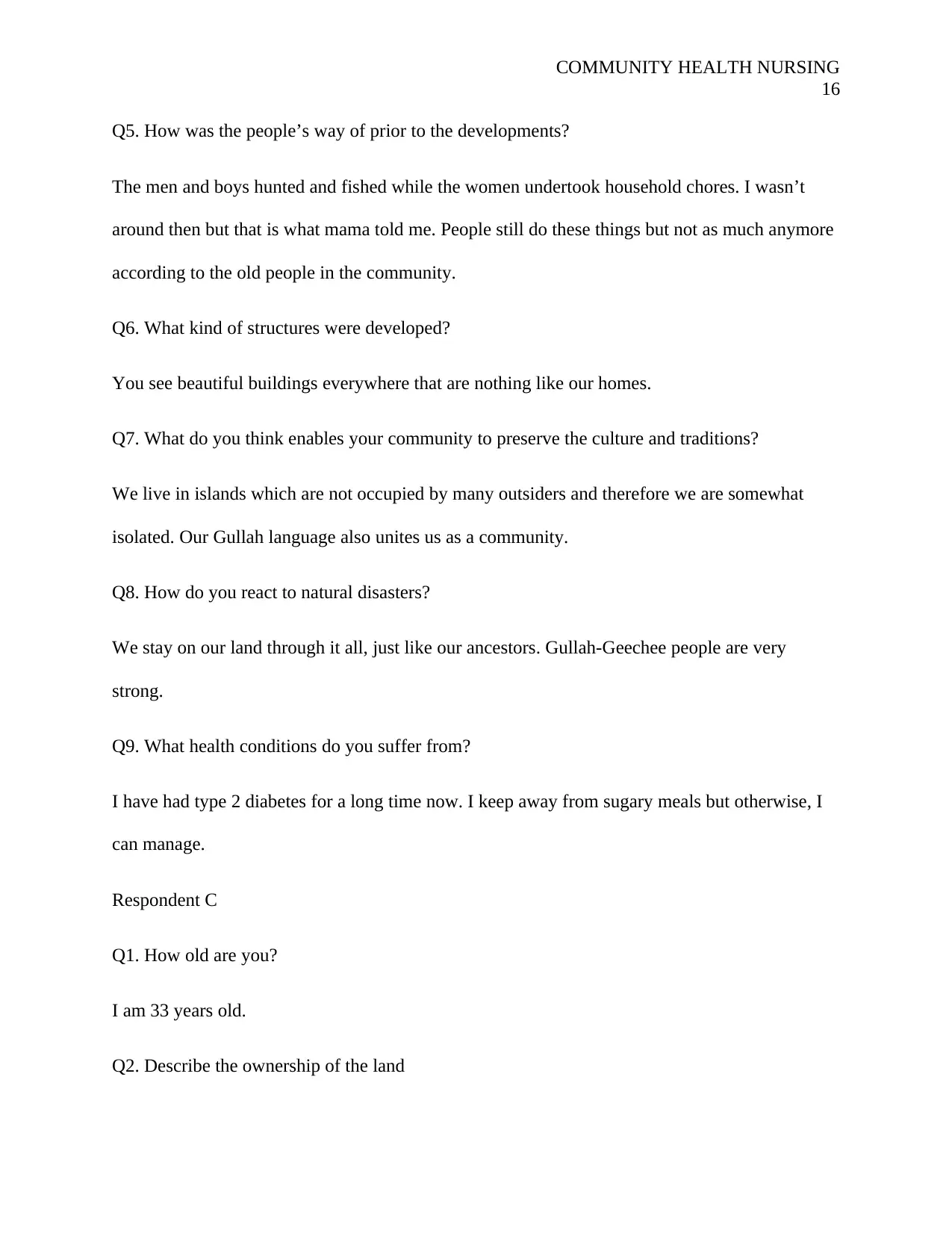
COMMUNITY HEALTH NURSING
16
Q5. How was the people’s way of prior to the developments?
The men and boys hunted and fished while the women undertook household chores. I wasn’t
around then but that is what mama told me. People still do these things but not as much anymore
according to the old people in the community.
Q6. What kind of structures were developed?
You see beautiful buildings everywhere that are nothing like our homes.
Q7. What do you think enables your community to preserve the culture and traditions?
We live in islands which are not occupied by many outsiders and therefore we are somewhat
isolated. Our Gullah language also unites us as a community.
Q8. How do you react to natural disasters?
We stay on our land through it all, just like our ancestors. Gullah-Geechee people are very
strong.
Q9. What health conditions do you suffer from?
I have had type 2 diabetes for a long time now. I keep away from sugary meals but otherwise, I
can manage.
Respondent C
Q1. How old are you?
I am 33 years old.
Q2. Describe the ownership of the land
16
Q5. How was the people’s way of prior to the developments?
The men and boys hunted and fished while the women undertook household chores. I wasn’t
around then but that is what mama told me. People still do these things but not as much anymore
according to the old people in the community.
Q6. What kind of structures were developed?
You see beautiful buildings everywhere that are nothing like our homes.
Q7. What do you think enables your community to preserve the culture and traditions?
We live in islands which are not occupied by many outsiders and therefore we are somewhat
isolated. Our Gullah language also unites us as a community.
Q8. How do you react to natural disasters?
We stay on our land through it all, just like our ancestors. Gullah-Geechee people are very
strong.
Q9. What health conditions do you suffer from?
I have had type 2 diabetes for a long time now. I keep away from sugary meals but otherwise, I
can manage.
Respondent C
Q1. How old are you?
I am 33 years old.
Q2. Describe the ownership of the land
Secure Best Marks with AI Grader
Need help grading? Try our AI Grader for instant feedback on your assignments.
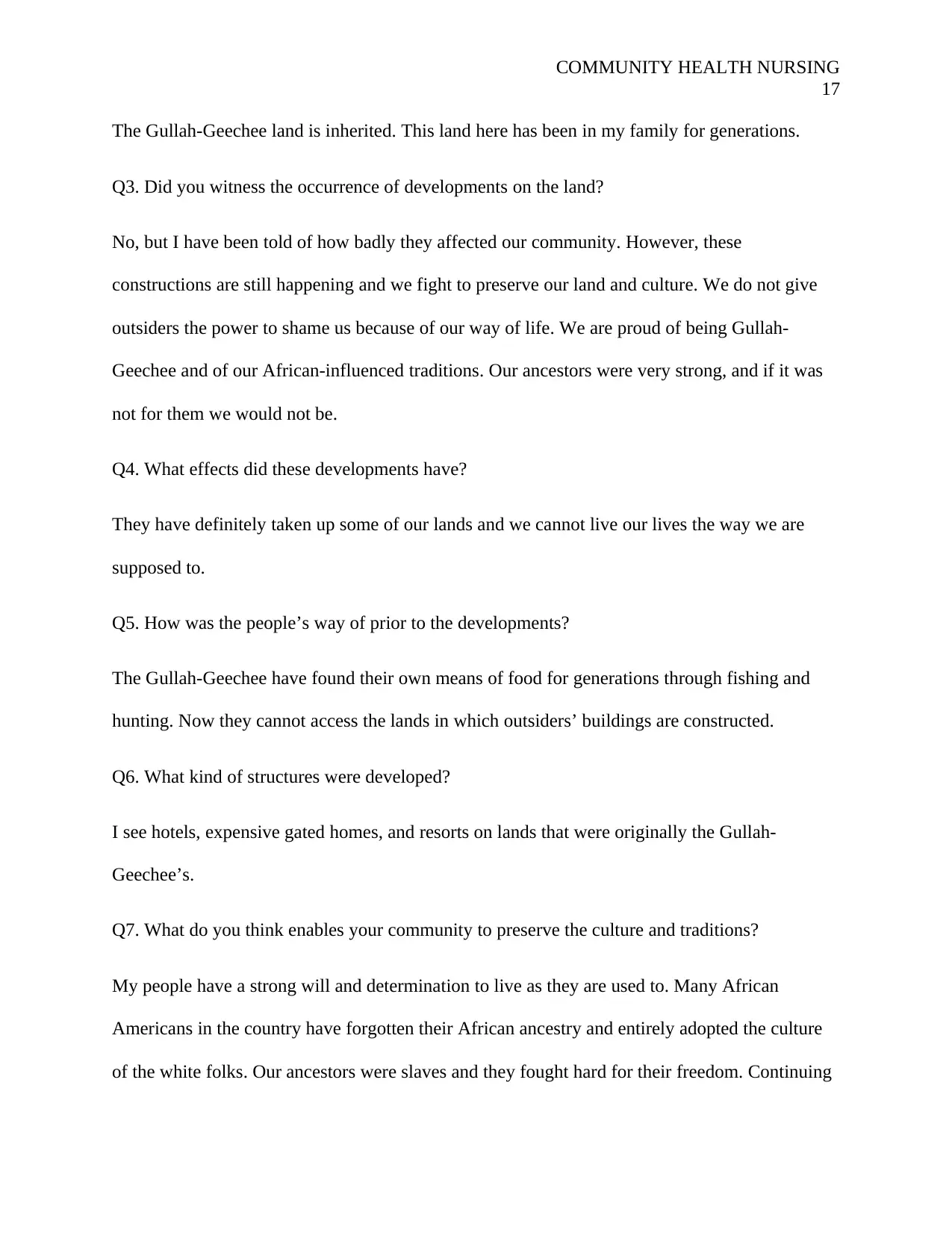
COMMUNITY HEALTH NURSING
17
The Gullah-Geechee land is inherited. This land here has been in my family for generations.
Q3. Did you witness the occurrence of developments on the land?
No, but I have been told of how badly they affected our community. However, these
constructions are still happening and we fight to preserve our land and culture. We do not give
outsiders the power to shame us because of our way of life. We are proud of being Gullah-
Geechee and of our African-influenced traditions. Our ancestors were very strong, and if it was
not for them we would not be.
Q4. What effects did these developments have?
They have definitely taken up some of our lands and we cannot live our lives the way we are
supposed to.
Q5. How was the people’s way of prior to the developments?
The Gullah-Geechee have found their own means of food for generations through fishing and
hunting. Now they cannot access the lands in which outsiders’ buildings are constructed.
Q6. What kind of structures were developed?
I see hotels, expensive gated homes, and resorts on lands that were originally the Gullah-
Geechee’s.
Q7. What do you think enables your community to preserve the culture and traditions?
My people have a strong will and determination to live as they are used to. Many African
Americans in the country have forgotten their African ancestry and entirely adopted the culture
of the white folks. Our ancestors were slaves and they fought hard for their freedom. Continuing
17
The Gullah-Geechee land is inherited. This land here has been in my family for generations.
Q3. Did you witness the occurrence of developments on the land?
No, but I have been told of how badly they affected our community. However, these
constructions are still happening and we fight to preserve our land and culture. We do not give
outsiders the power to shame us because of our way of life. We are proud of being Gullah-
Geechee and of our African-influenced traditions. Our ancestors were very strong, and if it was
not for them we would not be.
Q4. What effects did these developments have?
They have definitely taken up some of our lands and we cannot live our lives the way we are
supposed to.
Q5. How was the people’s way of prior to the developments?
The Gullah-Geechee have found their own means of food for generations through fishing and
hunting. Now they cannot access the lands in which outsiders’ buildings are constructed.
Q6. What kind of structures were developed?
I see hotels, expensive gated homes, and resorts on lands that were originally the Gullah-
Geechee’s.
Q7. What do you think enables your community to preserve the culture and traditions?
My people have a strong will and determination to live as they are used to. Many African
Americans in the country have forgotten their African ancestry and entirely adopted the culture
of the white folks. Our ancestors were slaves and they fought hard for their freedom. Continuing
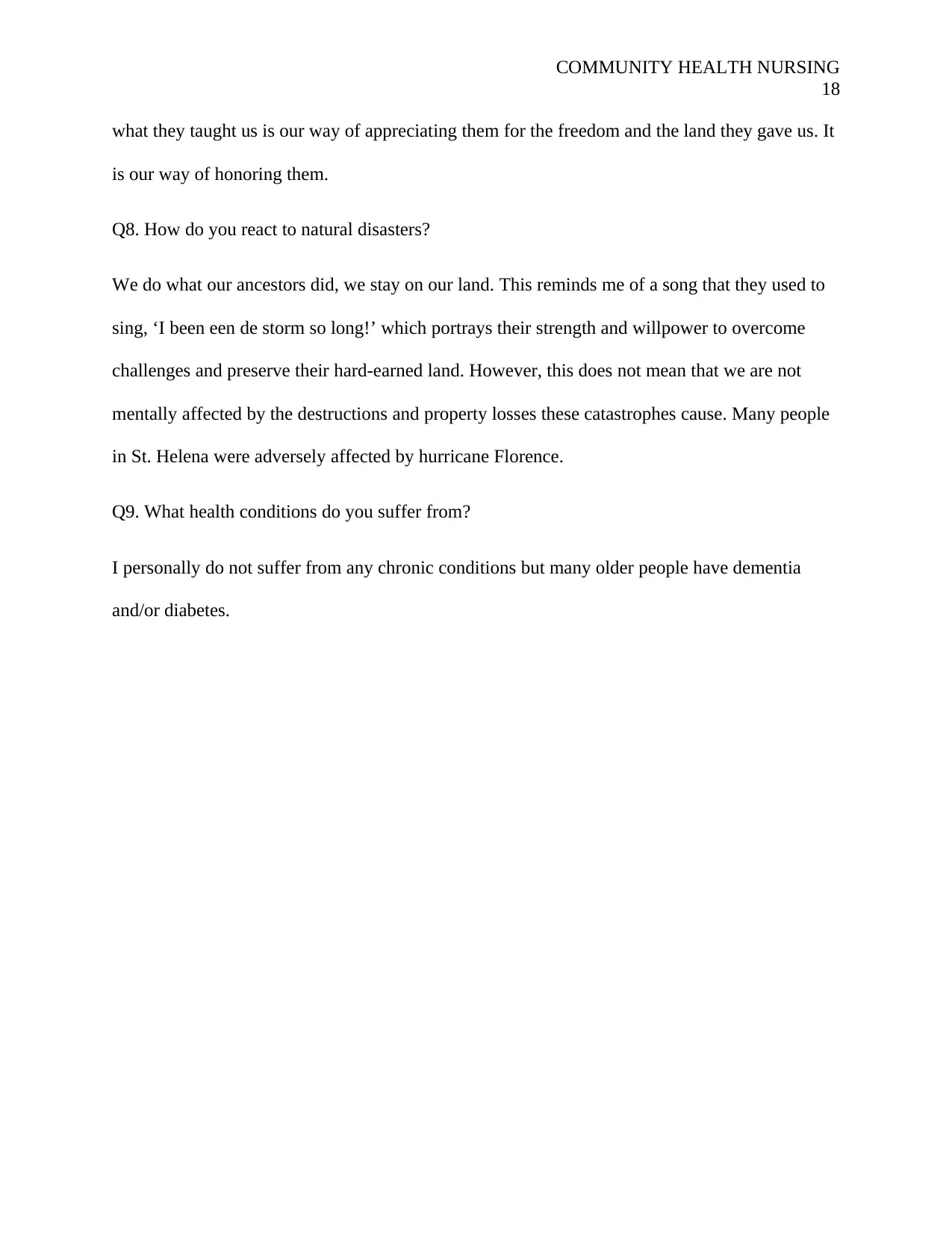
COMMUNITY HEALTH NURSING
18
what they taught us is our way of appreciating them for the freedom and the land they gave us. It
is our way of honoring them.
Q8. How do you react to natural disasters?
We do what our ancestors did, we stay on our land. This reminds me of a song that they used to
sing, ‘I been een de storm so long!’ which portrays their strength and willpower to overcome
challenges and preserve their hard-earned land. However, this does not mean that we are not
mentally affected by the destructions and property losses these catastrophes cause. Many people
in St. Helena were adversely affected by hurricane Florence.
Q9. What health conditions do you suffer from?
I personally do not suffer from any chronic conditions but many older people have dementia
and/or diabetes.
18
what they taught us is our way of appreciating them for the freedom and the land they gave us. It
is our way of honoring them.
Q8. How do you react to natural disasters?
We do what our ancestors did, we stay on our land. This reminds me of a song that they used to
sing, ‘I been een de storm so long!’ which portrays their strength and willpower to overcome
challenges and preserve their hard-earned land. However, this does not mean that we are not
mentally affected by the destructions and property losses these catastrophes cause. Many people
in St. Helena were adversely affected by hurricane Florence.
Q9. What health conditions do you suffer from?
I personally do not suffer from any chronic conditions but many older people have dementia
and/or diabetes.
1 out of 18
Your All-in-One AI-Powered Toolkit for Academic Success.
+13062052269
info@desklib.com
Available 24*7 on WhatsApp / Email
![[object Object]](/_next/static/media/star-bottom.7253800d.svg)
Unlock your academic potential
© 2024 | Zucol Services PVT LTD | All rights reserved.
